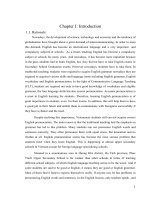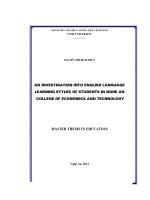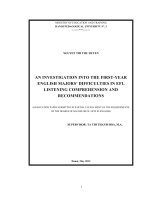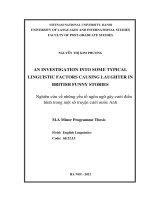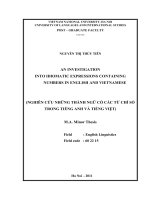An investigation into phonology problems encounter by beginner students in TOEIC listening section = Nghiên cứu những vấn đề về âm vị học mà học sinh trình độ sơ cấp gặp phải trong phần nghe TOEIC
Bạn đang xem bản rút gọn của tài liệu. Xem và tải ngay bản đầy đủ của tài liệu tại đây (944.7 KB, 61 trang )
VIETNAM NATIONAL UNIVERSITY, HANOI
UNIVERSITY OF LANGUAGES AND INTERNATIONAL STUDIES
FACULTY OF POST-GRADUATE STUDIES
*********************
VÕ THIÊN AN
AN INVESTIGATION INTO PHONOLOGY PROBLEMS
ENCOUNTERED BY BEGINNER STUDENTS IN TOEIC
LISTENING SECTION
Nghiên cứu những vấn đề về âm vị học mà học sinh trình độ sơ cấp gặp phải
trong phần nghe TOEIC
M.A MINOR THESIS
FIELD: ENGLISH TEACHING METHODOLOGY
CODE: 60140111
Hanoi, 2014
VIETNAM NATIONAL UNIVERSITY, HANOI
UNIVERSITY OF LANGUAGES AND INTERNATIONAL STUDIES
FACULTY OF POST-GRADUATE STUDIES
*********************
VÕ THIÊN AN
AN INVESTIGATION INTO PHONOLOGY PROBLEMS
ENCOUNTERED BY BEGINNER STUDENTS IN TOEIC
LISTENING SECTION
Nghiên cứu những vấn đề về âm vị học mà học sinh trình độ sơ cấp gặp phải
trong phần nghe TOEIC
M.A MINOR THESIS
FIELD: ENGLISH TEACHING METHODOLOGY
CODE: 60140111
SUPERVISOR: PHẠM HỮU ĐỨC, Ph.D.
Hanoi, 2014
i
DECLARATION OF AUTHORSHIP
I, Võ Thiên An, hereby declare that the thesis entitled “An investigation into
phonology problems encountered by beginner students in TOEIC listening section”
and the work presented in it is entirely my own. Where I have consulted the work of
others, this is always clearly stated.
Signed: ___________________ Date: _________________
ii
ACKNOWLEDGEMENTS
I would like to take this opportunity to express my gratitude to all my lecturers at
the Faculty of Post-graduate Studies, University of Languages and International
Studies, Vietnam National University, Hanoi whose support and considerations have
enabled me to pursue the course.
I would like to express my deepest thank to Mr. Phạm Hữu Đức, Ph.D, my
supervisor, for his instructive suggestions and valuable comments on the writing of this
thesis. Without his help and generous encouragement, this minor thesis would not have
been accomplished.
I am also thankful to Mr. Vĩnh Huy, M.A, Ms. Chung Thị Thanh Loan, the
employees and all my students from class TOEIC 300.21 and TOEIC 300.22 of Go
Ahead center for their whole-hearted assistance in this study.
I also owe my sincere gratitude to Mr. Vũ Minh Ngọc, M.A, my uncle Mr.
Nguyễn Diệu and my cousin Ms. Nguyễn Diệu Minh who spent time to share their
useful ideas for my thesis.
Last my thanks would go to my beloved family, my friends and my boyfriend
for their loving consideration as well as their share in listening to me and helping me to
work out my problems during the difficult course of the minor thesis.
iii
ABSTRACT
The score of TOEIC test in listening and reading reflects the proficiency of
using English to communicate with native and non- native speakers of learners. In the
recent years, Vietnamese students have considered TOEIC as a key to find a good job,
get promotion or study abroad however they still find it difficult to be good at listening
section in TOEIC because of some linguistic obstacles. This study is conducted to
investigate some phonology problems that hinder students‟ success in TOEIC listening
section. The data was collected through the survey questionnaires of 30 students and
the interview of 2 teachers at a center in order to find out students‟ phonology
problems in TOEIC listening section as well as the solutions for these problems.
Key words: TOEIC listening section, phonology problems, beginner students,
solutions.
iv
TABLE OF CONTENTS
DECLARATION OF AUTHORSHIP i
ACKNOWLEDGEMENTS ii
ABSTRACT iii
TABLE OF CONTENTS iv
LIST OF ABBREVIATIONS viii
LIST OF TABLES ix
PART A: INTRODUCTION 1
1. Rationale: 1
2. Aims and Objectives of the study: 2
3. Research questions: 2
4. Scope of the study 3
5. Method of the study 3
6. Organization of the study 3
PART B: DEVELOPMENT 5
CHAPTER 1: LITERATURE REVIEW 5
1.1. English listening and its importance 5
1.1.1. Theoretical background of listening and listening comprehension 5
1.1.2. The importance of listening 7
1.2 TOEIC listening section: 7
1.3. Phonetics & Phonology in English listening 8
1.3.1. Definition of phonetics & phonology 8
1.3.2. Role of phonetics & phonology in Listening 8
1.3.3. Listening Comprehension Obstacles regarding to Phonetics & Phonology . 10
1.4. Phonetic & Phonology problems students may encounter in TOEIC listening
section: 11
v
1.4.1. Sounds 11
1.4.2. Accent 12
1.4.3. Stress 13
1.4.4. Intonation 14
1.4.5. Connected speech 15
1.4.5.1. Weak forms 16
1.4.5.2. Reduced forms 17
1.4.5.3. Linking of words (liaison) 18
CHAPTER 2: METHODOLOGY 20
2.1. Setting of the study and participants 20
2.1.1. Setting of the study 20
2.1.2. Participants 20
2.2. Data Collection 20
2.2.1. Data Collection Instruments 20
2.2.2. Data collection procedures 21
2.2.3. Data analysis procedure 21
CHAPTER 3: DATA ANALYSIS AND DISCUSSION 23
3.1. Findings from the questionnaire: 23
3.1.1. Students‟ evaluation of their listening ability: 23
3.1.2. Students‟ evaluation of the importance of English listening skill 23
3.1.3. Students‟ evaluation of the difficulties of TOEIC listening section: 24
3.1.4. Students‟ frequency of having phonetic & phonology problems in TOEIC
listening section 25
3.1.4.1. Students‟ problem with same and similar sounds 26
3.1.4.2. Students‟ problem with variety of accents 26
3.1.4.3. Students‟ problem with stress 27
3.1.4.4. Students‟ problem with intonation of the speakers 27
vi
3.1.4.5. Students‟ problem with weak forms 28
3.1.4.6. Students‟ problem with reduced forms 28
3.1.4.7. Students‟ problem with linking of words 28
3.2. Findings from the interview: 29
3.2.1. Students‟ opinion about their reasons of problems 29
3.2.2 Teachers‟ interview 29
3.2.2.1. Teachers‟ opinion toward their students‟ problem with same and similar
sounds 30
3.2.2.2. Teachers‟ opinion toward their students‟ problem with accent 30
3.2.2.3. Teachers‟ opinion toward their students‟ problem with stress 31
3.2.2.4. Teachers‟ opinion toward their students‟ problem with intonation 31
3.2.2.5. Teachers‟ opinion toward their students‟ problem with weak forms 31
3.2.2.6. Teachers‟ opinion toward their students‟ problem with reduced forms 32
3.2.2.7. Teachers‟ opinion toward their students‟ problem with linking of words
32
3.2.2.8. Teachers‟ explanations for the main reasons for students‟ problems 33
3.2.2.9. Some strategies to help students to deal with phonology problems in
listening suggested by the interviewed teachers 33
3.3. Pedagogical implications: 34
3.3.1. Techniques to help students distinguish same or similar sounds 34
3.3.1.1. Distinguish minimal pairs 34
3.3.1.2. Missing words 36
3.3.2. Techniques to help students get familiar with accents, linking of words and
reduced forms 36
3.3.3. Techniques to help students get familiar with stress and intonation 37
3.3.3.1. Rubber band practice with nonsense syllables 37
3.3.3.2. Building up an intonation sentences: 38
PART C: CONCLUSION 39
vii
1. Conclusions of the study: 39
2. Limitations of the study: 40
3. Suggestions for the study: 40
REFERENCE 41
APPENDIX 1 I
APPENDIX 2 II
APPENDIX 3 III
DEFINITION OF TERMS
Listening: An ability to identify and understand others‟ speech
TOEIC test: An assessment of proficiency in English language which is used by both
native and non-native speakers in the global workplace.
Phonology: The study of sound systems
Accent: A distinctive way of pronouncing a language, especially one associated with a
particular country, area, or social class
Stress: Emphasis given to a particular syllable or word in speech, typically through a
combination of relatively greater loudness, higher pitch, and longer duration
Intonation: The rise and fall of the voice in speaking
Connected speech: Sandhi-variation or reduced forms
Weak forms: Unstressed syllables
viii
Reduced forms: The changes of pronunciation in adjacent words of sounds in spoken
language
Linking of words: The connection between the final sound of one word and the initial
sound of the next one
Phonology awareness: The ability to attend to the phonological or sound structure of
language as distinct from its meaning.
viii
LIST OF ABBREVIATIONS
TOEIC: Test of English for International Communication
TOEFL: Test of English as a Foreign Language
IELTS: International English Language Testing System
ESL: English as a Second Language
NAE: North American English
HCM city: Ho Chi Minh city
ix
LIST OF TABLES
Table 1: Students‟ evaluation of their listening ability 23
Table 2: Students‟ evaluation of the importance of English listening skill 23
Table 3: Students‟ evaluation of the difficulties of TOEIC listening section 24
Table 4: Students‟ frequency of having phonology problems in TOEIC listening 25
1
PART A: INTRODUCTION
1. Rationale:
In the era of globalization, using a foreign language fluently can help people
have more chances to approach society‟s progress. Among foreign languages, English
is the most popular language and is spoken all over the world. English is not only an
international language in politics, external affairs and economy, but it is also used in
international scientific activities. English is actually a means of effective
communication which connects people around the world closer and closer. As the
requirements of the new era, Vietnamese young generations have to adapt to the new
trend of the world by studying and using English.
In the recent years, studying and teaching English in Vietnam are more and
more developed. The appearances of international English tests like TOEFL, IELTS
and TOEIC really help Vietnamese students to approach the development of the world.
Among international English tests, TOEIC is applied in many universities, colleges and
English centers in Vietnam. Although TOEIC is very popular with many people all
over the world, Vietnamese students still have to face with many problems in studying,
especially the listening section in TOEIC.
As an ESL teacher at a center in Binh Thanh district in Ho Chi Minh City, my
duty includes teaching the TOEIC for students. After more than three years of teaching,
I have found that students here have to encounter with some difficulties in listening
such as the lack of vocabulary, the speakers‟ pronunciation, the linking of words, the
intonation and the speed of native speakers. The cause of these problems comes from
their habits of studying English at high school. Firstly, at high school, the English
studying curriculum focuses more on reading and grammar, and students rarely
2
approach to listening and speaking skills. Secondly, at young age, English in their
awareness is not as important as other subjects so they concern more on mathematic,
physics and chemistry. Lastly, the English they studied at high school primarily
concentrates on British English of which the pronunciation, accent, liaison, intonation,
vocabulary and grammar are sometimes different from what they learn and prepare for
TOEIC tests.
For these reasons, I would like to conduct my research “AN INVESTIGATION
INTO PHONOLOGY PROBLEMS ENCOUNTERED BY BEGINNER STUDENTS
IN TOEIC LISTENING SECTION”. My thesis will seek the phonetic and
phonological difficulties that students meet in TOEIC listening process in order to find
out some techniques to improve their listening ability.
2. Aims and Objectives of the study:
My study is conducted with these main purposes:
- To explore the students‟ perceptions of the TOEIC listening test
- To investigate what phonology problems beginner students meet in the TOEIC
listening process.
- To suggest some suitable activities to help students overcome them.
3. Research questions:
The research is conducted to answer 2 following questions:
1. What are the students‟ attitudes and perceptions to TOEIC listening section?
2. What phonology problems do beginner students meet in the TOEIC listening
process?
3
4. Scope of the study
This study focuses on some phonology problems that beginner students at the
center in Binh Thanh district often meet in TOEIC listening section. These problems
will be identified through the result of the questionnaire and the interview. The
researcher also suggests some useful techniques and solutions for these ones.
5. Method of the study
This study is a case study which used the interview and the survey questionnaire
to collect data. The questionnaire was designed to find out the students‟ attitudes
toward the listening TOEIC section and their difficulties regarding to phonetics &
phonology in their listening process. Besides, this study also contained the interview
from students and teachers in order to ensure the validity and the reliability of the data.
6. Organization of the study
To achieve the aims of the study, this paper is divided into three main parts.
They are INTRODUCTION, DEVELOPMENT, and CONCLUSION.
INTRODUCTION includes the reasons of choosing the thesis, the aims, the
scope, the research questions, the methods and the organization of the study.
DEVELOPMENT consists 3 chapters. Chapter 1 presents the theoretical
background relevant to the research. Firstly, some basic concepts of phonetics,
phonology, listening and the TOEIC listening test are introduced. Then, the phonology
problems that hinder students in TOEIC listening section are also presented. Chapter 2
is the research methodology. In this chapter, I will introduce the subject of the study,
the instruments used to collect data and the procedure of data collection. Chapter 3
presents data analysis and discussion. The data will be analyzed through two
instruments: questionnaire and the student and teacher interview. I also interpret the
4
findings. Some techniques and activities are also suggested to help teachers and
students to overcome phonology difficulties in TOEIC listening section.
The last part which is the summary of the findings is CONCLUSION. This part
also includes the limitations of the study as well as some recommendations for further
study.
5
PART B: DEVELOPMENT
CHAPTER 1: LITERATURE REVIEW
1.1. English listening and its importance
1.1.1. Theoretical background of listening and listening comprehension
When discussing „Listening as comprehension‟ in his book, Richards (2008:3)
indicates that listening comprehension is the traditional thought of the listening nature.
He points out “in most methodology manuals listening and listening comprehension
are synonymous”. He explains this point of view based on “ the main function of
listening in second language learning is to facilitate understanding of spoken
discourse.”
There are many definitions of listening with variable viewpoints have been
suggested by scholars for years. Vygotsky (1962) as cited in Kuo (2009) states his own
ideas about listening that listening is considered as the first intake that “involves
thoughts delivered to human‟s mind through speech” in order to gain the language
output and listening comprehension. Lynch & Mendelsohn (2002) ensure that in the
past listening was considered as a passive process that our ears just received
information and the listener passively registered the massage. However, they also give
a new point of view of listening at present, they think that now listening is as an active
process and good listeners are active when listening like native speakers.
Bentley & Bacon (1996) also defined listening as an active process during
which the listener constructs meaning from oral input. Purdy (1997:8) has the same
idea as Bentley & Bacon by giving a definition of listening, "the active and dynamic
process of attending, perceiving, interpreting, remembering, and responding to the
6
expressed (verbal and nonverbal), needs, concerns, and information offered by other
human beings". Having the same idea, Thomlison (1984) indicates that listening is an
ability to identify and understand others‟ speech. This process includes understanding
speakers‟ accent or pronunciation, grammar, vocabulary and meaning comprehension.
An able listener has ability to do all four things simultaneously. Whereas, Underwood
(1989:1) simply defines listening as "the activity of paying attention to and trying to
get meaning from something we hear".
Some researchers state that listening comprehension is considered as a channel
for comprehensible input (Krashen, 1985) and as an important aspect of interlanguage
communication in language acquisition (Swain, 1985). Hasan (2000:138) also
emphasizes the role of listening comprehension as “listening comprehension provides
the right conditions for language acquisition and development of other language
skills”. Talk about listening comprehension, Murphy (1991:56) described it as an
“interactive, interpretive process in which listeners engage in a dynamic construction
of meaning”.
Listening comprehension is regarded as a complex, interactive process in
which listeners are involved in a dynamic construction of meaning. Listeners
understand the oral input from sound discrimination, prior knowledge of vocabulary,
grammatical structures, stress and intonation, as well as other use linguistic,
paralinguistic, or even non-linguistic clues in contextual utterance (Rost, 2002).
Vandergrift also defines listening comprehension as
“a complex active process in which the listener must discriminate between
sounds, understand vocabulary and grammatical structure, interpret stress and
intonation, retain what was gathered in all the above and interpret it with the
immediate as well as the larger sociocultural context of the utterance”. (Vandergrift,
1999: 168)
7
1.1.2. The importance of listening
Wolvin & Coakley (1988) states that listening comes before speaking, reading
and writing and it is the first skill developed. Feyten (1991) also emphasizes the
importance of listening in communication by giving specific data in his research. He
points out in the four skills, listening provides the largest percentage (more than 45%)
of our total communicative competence, followed by speaking (30%), reading (16%),
and writing (9%). Goh (2000) thinks listening is the primary means by which incoming
ideas and information are taken in. Brett (1997: 39) also states that "listening is a key
language skill. It has a vital role in the language acquisition process". Vandergrift
(2007) emphasizes the importance of listening as the heart of language learning and the
important skill to develop second language acquisition Rost (2002) also indicates that
the ability of learners to use listening as a means of acquisition is a key difference
between more successful and less successful acquirers. Besides, Rost states that
progress in listening will provide a foundation for development of other language
skills. Harmer (2007) also shares the same opinion with Rost. According to Hammer,
listening is not alone in its process; it also contains and supports the other skills.
Moreover, he confirms that listening skill can help student to improve pronunciation,
intonation and the sounds of not only individual words but also those which go
together in connected speech.
1.2 TOEIC listening section:
TOEIC test is an assessment of proficiency in English language which is used
by both native and non-native speakers in the global workplace. TOEIC test is
considered as “a worldwide standard in assessment of international English use.”
(Schedl, 2010: 1)
In the English listening section of TOEIC test students will have the chance to
show how well they understand spoken English. This section of the TOEIC test
8
includes 4 parts: Picture description, questions and responses, short conversation and
short talk. (Byrne & Taylor, 2007:1-7)
1.3. Phonetics & Phonology in English listening
1.3.1. Definition of phonetics & phonology
Phonetics and phonology are the abstract issues of linguistics. Many scholars
give different definition of phonology for ages, but in general, they have the same
opinion that “phonology is the study of sound systems” or “the study of how speech
sounds structure and function in languages”, (Hyman, 1975:2). Hyman also
distinguish clearly between phonetics and phonology. According to him, phonetics is
about how the sounds are made and their acoustic properties. Phonology is about how
these sounds convey the meaning. Forel & Puskás also agree with Hyman by citing the
Vikner‟s definition in their book about Phonetics and Phonology:
“Phonetics is concerned with how sounds are produced; transmitted and perceived (we
will only look at the production of sounds). Phonology is concerned with how sounds
function in relation to each other in a language. In other words, phonetics is about
sounds of language, phonology about sound systems of language. Phonetics is a
descriptive tool necessary to the study of the phonological aspects of a
language.”(Vikner (1986) as cited in Forel & Puskás , 2005:3)
In Dictionary of Phonetics and Phonology of Trask (1996: 275), phonology is
also defined as “the branch of linguistics dealing with the relations among speech
sounds in particular languages and in languages generally, and contrasting with
phonetics.”
1.3.2. Role of phonetics & phonology in Listening
Many researchers find that pronunciation, phonetic and phonology have an
important role in students‟ communication ability. According to Vandergrift (2007),
9
Rost (2002), listening involves many simultaneous processes on different levels
together with a combination of linguistic (e.g., phonological, lexical, syntactic,
semantic, or pragmatic knowledge) and non-linguistic knowledge (e.g., knowledge of
the context, topic, or general knowledge of the world). Bacon (1989) also states that a
listener needs to have knowledge about major components of the language such as
phonology, lexicon, syntax, semantics, and text structure.
In the research in 1998, Berne pointed out some facts about listening
comprehension in which there is a fact related to the relationship between phonology
and listening comprehension of learners. She states that lower- proficiency L2 students
attend to phonology or semantics cues, whereas higher proficiency L2 students attend
to semantics cues.
Habibi et al. (2013) judge in communication competence, the ability to hear
words correctly is even more difficult than to say them correctly. In order to understand
and be understood by the others, we have to have the knowledge and use of the
language‟s pronunciation. According to them, the terms pronunciation and phonetics
are often used interchangeably and phonology is a study of sounds which mostly
analyses the function of sounds in communication. They also suggest students focus on
individual sounds‟ pronunciation in order to distinguish individual words in listening
comprehension. Besides, understanding rhythm or intonation is really helpful for
students to perceive longer utterances and decide on the most essential information.
Brown, Currie & Kenworthy (1980) admit that the tone of the speakers can transmit
meaning that why they have researched a variety of aspects of intonation; the vocal
elements are the neutral patterns of basic stress, rhythm and intonation. The nuances of
meaning can be transmitted by changes in tone quality, rate, rhythm, stress and many
other features. Stahr (2009) also agrees that teachers should pay attention to the
rhythmic cues such as stress and intonation because they are very important even in
10
fast speech where the phoneme may be missing. Therefore, he suggests students to
focus on the phonological features of the vocabulary in order to indentify the word or
the phrase in spoken form. Celce-Murica (1996) insists there should be a close link
between pronunciation and listening comprehension because communication
competence requires the knowledge of sounds, intonation, stress pattern and how
speech is organized. She also lists four crucial elements to decode speech of native
speakers that are „Discerning intonation units‟, „Recognizing stressed elements‟,
„Interpreting unstressed elements‟, „Determining the full forms underlying reduced
speech‟.
1.3.3. Listening Comprehension Obstacles regarding to Phonetics & Phonology
Chiang & Dunkel (1992) claim that phonological features and background
knowledge is the factor that affects listening comprehension process of students.
According to White (1998) as cited in Gonzalez &Vargas (2009), listening
requires some sub skills such as recognizing individual sound, discriminating between
sounds, identifying reduced forms in fast speech, identifying stressed syllables,
identifying stressed words in utterances, recognizing intonation patterns in listening
comprehension. Shelton (2008) states that in listening comprehension process, people
may encounter different accents or pronunciation, unfamiliar lexical items and
syntactic structures, competing background noise and make a conscious effort to not be
distracted while listening. In order to understand the meaning of the given message,
listeners must deal with these problems nearly simultaneously.
Brown (2001:252) finds out eight factors that affect the listening comprehension
process related to phonetics & phonology includes: Clustering, Redundancy, Reduced
Forms, Performance variables, Colloquial language, Rate of delivery, Stress, Rhythm,
and Intonation and Interaction.
11
Jia & Fu (2011) mentions some common listening obstacles in which there are
some problems regard to phonology such as wrong pronunciation, misunderstanding of
intonation and unknowing about the phonetic phenomena. They cites ideas of Wong
(1993) that phonetics knowledge, pronunciation and intonation severely hinders
student‟s improvement in listening ability. For the phonetic phenomena, Jia & Fu also
explain that native English speakers speak very fast and using a lot of stressed
syllables, liaison and contractions that might prevent students from understand what is
spoken.
Cauldwell (1996) explained that the problems with „speed‟ of speaking are
related to difficulties in understanding reduced forms, distinguishing word boundaries
and recognition of non prominent words.
1.4. Phonetic & Phonology problems students may encounter in TOEIC listening
section:
1.4.1. Sounds
According Jia & Fu (2011) sounds are not only the direct means in listening and
listening but also the basic component and element of language. They also mention
good listening comprehension requires good pronunciation because inaccurate
pronunciation can impact the students‟ understanding.
Talking about students‟ problem in listening, Ur (2007) points out the students
cannot realize English sounds in listening accurately because some of sounds do not
exist in their own language. For example, there are some sounds that do not exist in
Vietnamese such as the sound /
/ as in „thank‟, or /ð/ in „this‟. Besides, Goh (2000)
recognizes students have problems on distinguishing of familiar words. Although
students were familiar with some words, they could not remember the meaning of the
words immediately.
12
The answer choices in TOEIC listening section often contain words or phrases
of which sounds are often the same or similar in the listening text. This phenomenon
makes students often feel a little confused during the listening process. For example,
“walking” and “working” are two words that Vietnamese students often confused with
because these two words sound quite similar with them. Besides, listening to
homophones like “two”, “to” or “too” is really a big challenge for beginners.
1.4.2. Accent
Derwing & Munro (2005:383) consider accent as a “normal consequence of
second language learning” in which listeners can know how different the accent of the
speaker from of the first language community is.
Schedl (2010) points out the Classic TOEIC listening included only standard
American accents. However, TOEIC test is a test of international English and the
design team proposed varying the accents used in the listening. Therefore, the TOEIC
listening test reflects the varieties of Standard English. Therefore, Trew (2007) advises
students to get familiar with the different native accents because the TOEIC listening
section often includes American, Canadian, British and Australian Speakers.
The problem that Vietnamese students often deal is dialect such as the American
accent or others because they rarely study all of them at high school. The English
which Vietnamese students often study at high school mainly concentrate on British
English in both vocabulary and pronunciation.
Gomez (2012) points out some main differences between British English and
American English in pronunciation in his study include: rhetoric accent, differences in
vowel pronunciation, for example, the changes of diphthong /əʊ/, vowels /ɔ/, /æ/, and
/ju:/ and differences in pronouncing consonant with the typical example is the flapping
/t/.
13
Although American accent is just a part of Standard English, Vietnamese
students often feel stressed when listening to texts with American accents. For
example: The course book “Very easy TOEIC” contains some sentences with the
flapping /t/ such as “They‟re fighting”, “He is writing”. Although the structure and
meaning of two sentences are simple, students feel hard to distinguish between
“They‟re fighting” and “They‟re finding” or “He is writing” and “He is riding”.
1.4.3. Stress
Buck (2001) states that speakers stress what they think are important, and take
additional stress for the most important words which contain the core meaning.
Singer(2012) discovers that Vietnamese is a syllable- timed language, where as
English is a stress- timed language. In syllable-timed language, all the syllables
take roughly the same amount of time to say. In stress-timed language, syllables
are lengthened and reduced according to whether or not they are stressed. It is very
hard for speakers of syllable-timed languages to get the hang of stress-timing, so
this feature will persist, strengthening the staccato rhythm of Vietnamese English.
Beside the stressed syllable in a word, English also has sentence stress or
prominence which also occurs in TOEIC listening. Prominence is the outstanding
makes listeners pay attention to a word more than others in context by making the
accented syllables (Celce- Murcia et al: 2002). The word we place stress in English
sentence is very important because it affects the meaning of the whole sentences. For
example:
A: What did you like the movie?
B: It was pretty good. (I liked it)
It was pretty good. (I did not like it much)
